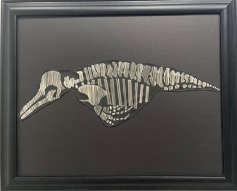by Haley Miller
Emma Sink, a resident of Valdosta, GA, is a participant in the Spring 2025 senior exhibition, “Nexus,” at Valdosta State University. The show features all the graduating art seniors, focusing on themes such as life, family, and the personal interests of the students. The main themes that Sink pursues are life, death, and the process of grieving. Grieving can be due to death, but people can also grieve in life for a multitude of reasons, which is something she likes to explore. She establishes that she has a rather dark personality, and that is why she tends to focus on themes such as death. However, she wants to find the beauty within death and within memories. For her viewers, she hopes that they look past the gruesomeness and face value of her work to really question what it means behind the bones and the intricate details.
Emma Sink describes her creative process and how she begins a new piece. She starts by picking an animal that she likes or that recalls a specific memory or person for her. She will then use that animal in her art, whether it’s drawing, embroidery, or three-dimensional art. Before beginning the piece, she will make sketches to ensure that she accurately represents the anatomy of the animal, like making sure she has the right number of spinal bones. Just like many artists have experienced in their creative journeys, Sink mentions that she often has creative blocks. Sometimes, she will get frustrated with a piece and not finish it for some time. Instead, she will start working on something else, which usually ends up turning out how she wanted the first piece to. In this way, she says that her “blocks” could really be described as a time when “it’s just not panning out, so let me focus on something else.”

Inia Geoffrensis, an artwork looking at the bone structure of an Amazon River dolphin, is an “homage” to Sink’s grandmother, who passed away a few years ago. She refers to this aquatic species as “pink dolphins,” a topic that her and her grandmother would often debate on whether they existed or not (Sink points out that they do, in fact, exist, hence her artwork). The materials for this piece include thread and canvas, as she embroidered the skeletal framework with translucent white thread onto a black canvas. The piece is formally minimalistic in this way, but the meaning behind it is far greater than a study of the pink dolphin. This interest in animal bone structure comes from an association with memorialization. Like people are remembered through photos and memories, animals are remembered through the bones they leave behind. Inia Geoffrensis is a creation that will allow her to look back and remember those conversations her and her grandmother would have.

Ai and Me, a piece that is divided into three consecutive canvases, connects the decomposition stages of an animal to the stages of grief: “The same way as an animal decomposes, you grieve in stages. In the beginning, everything is fine, everything is alive, and you have joy… As time goes on, the pain never leaves, just like the bones of an animal never leave.” In the first section, viewers see a beached whale that is still alive and in its original form. In the last section, the only thing left of the whale is its bones, signified by the bones of the whale’s tail. This skeleton shows that grief, although fully broken down, is ever-present.

Balaeniceps Rex, one of Sink’s ceramic pieces, is another example of using anatomy to reference grief. It consists of two long slabs of clay, incised to mirror the skeletal system of a shoebill, also known as a whale-headed stork. It is glazed in a dark blue, reminiscent of freshwater swamps and marshes where shoebills typically live. This interest in birds comes from the idea that birds, such as cardinals, come to visit loved ones as a symbol of someone who has passed. Although only two of her pieces in the exhibition are ceramics, Sink mentions that clay is her favorite medium. She prefers to work with her hands as it brings a calmness to her, so she typically sticks to hand-building, where she can work at her own pace and make sure she gets all the details that she desires.
Some of Emma Sink’s biggest influences are her teachers here at VSU who have encouraged her to express herself through her art. As she mentions, some teachers have strict rules about what they want to see, while others give students the artistic freedom to explore their interests and find their unique art style. To her, success as an artist looks a little different than typical goals: “Honestly, if just one person likes my art.” She admits that she is her worst critic and just hearing that someone else genuinely likes it is enough for her to feel accomplished. She does not care to have artworks that sell for millions of dollars; she just wants to be able to make a stable career, which is something that many emerging artists can relate to. Her next goal in her career is to move somewhere like Cheyenne, Wyoming, where there is a growing art scene. She plans to find a job there and save money to potentially go back to school for biology, where she can further her knowledge of anatomy, as that is an important interest of hers. Her associations between the lives of animals and the lives of people are key to understanding the themes prevalent in her art.